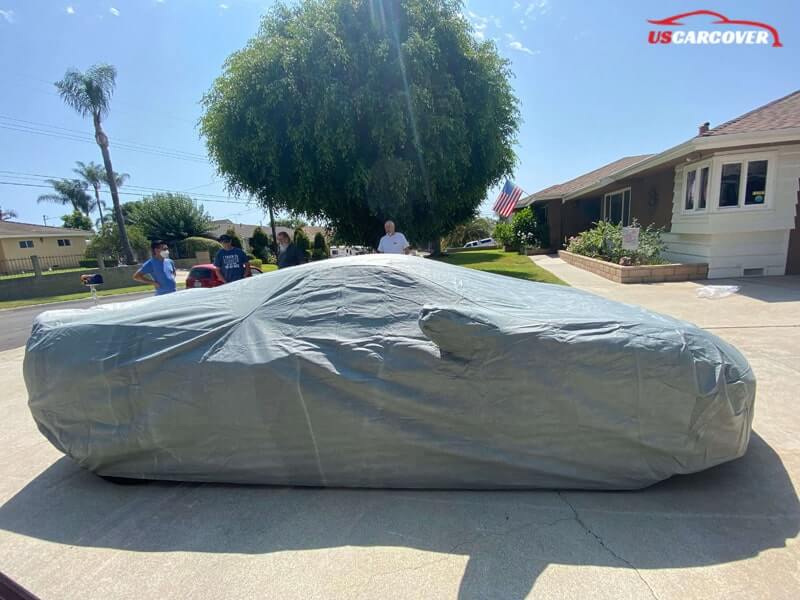
When the summer sun is at its peak, the last thing you want is for your vehicle to suffer under its relentless heat. Hot weather, particularly the intense UV rays from the sun, can cause significant damage to both the exterior and interior of your car. Over time, this exposure can lead to faded paint, cracked dashboards, and even weakened upholstery. Whether you park your vehicle in the driveway or on the street, prolonged exposure to the sun’s harmful rays can cause more harm than you might realize.
This is where a UV-protective car cover comes in. A high-quality car cover designed specifically for hot weather can act as a shield against the harsh effects of the sun. It not only protects your car from the immediate heat but also blocks out those damaging UV rays that accelerate wear and tear. From maintaining the glossy shine of your paint to preventing your interior from becoming a furnace, a good car cover is essential for keeping your car in top shape.
In this guide, we will explore the best car covers for hot weather, focusing on options that offer maximum UV protection. Whether you're looking for a budget-friendly option or a premium cover, this article will help you make an informed decision. By the end, you’ll know exactly what to look for and how to choose the perfect cover to keep your vehicle safe, cool, and well-protected all year round.
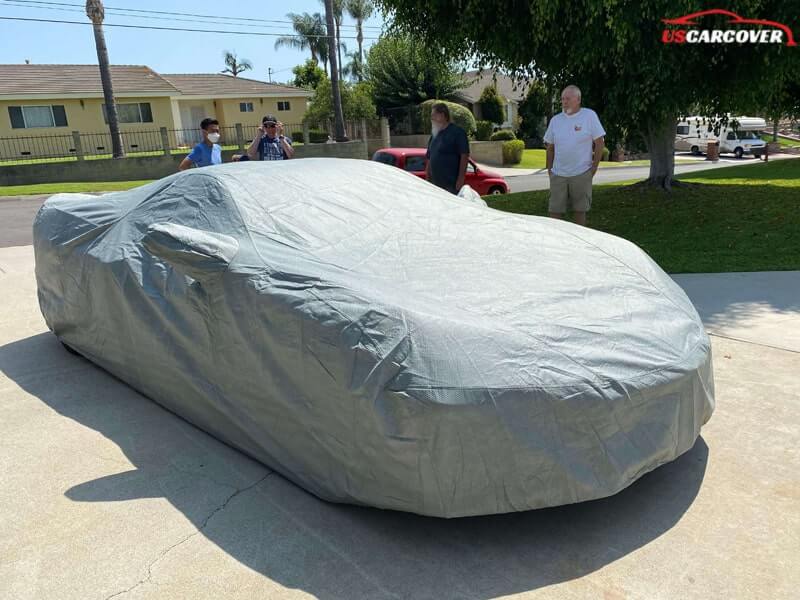
Why You Need a Car Cover with UV Protection
As the summer sun beats down, it’s easy to underestimate the toll that UV rays can take on your vehicle. While most people think about sun protection in terms of skin, your car’s exterior and interior are just as vulnerable to damage. Here are the key reasons why investing in a UV-protective car cover is crucial for anyone living in a hot climate.
Protects Your Paintwork
The vibrant color of your car's paint is one of its most defining features. However, prolonged exposure to the sun’s UV rays can cause the paint to fade, dull, or even peel over time. This oxidation process not only makes your car look older but can also lower its resale value. A UV-resistant car cover acts like sunscreen for your vehicle, shielding the paint from these harmful rays and preserving its original shine and color for years to come.
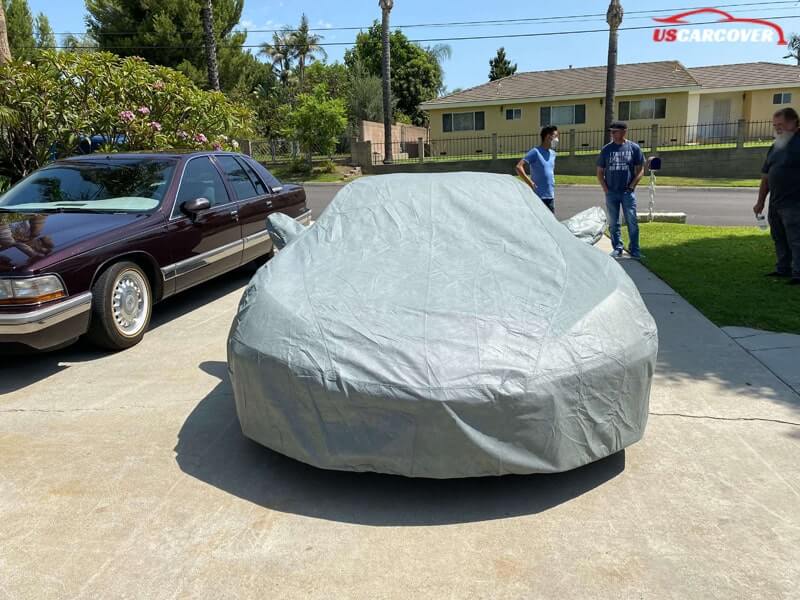
Prevents Interior Damage
It’s not just the exterior that’s at risk—your car’s interior can suffer just as much from excessive sun exposure. UV rays can cause your dashboard to crack, warp, or discolor. Leather seats can become brittle and fade, while fabrics may weaken or fade over time. The heat trapped inside a car parked under the sun can turn your interior into a scorching oven. A UV-protective car cover reflects sunlight, helping to keep your cabin cooler and protecting delicate materials from damage.
Reduces Heat Build-Up
Ever opened your car door after it's been sitting in the sun and felt a blast of hot air? That’s the result of heat build-up, which can make your car unbearable to drive without blasting the air conditioner. Car covers designed for hot weather are often made with heat-reflective materials that help to keep your vehicle cool by deflecting the sun’s rays. This not only makes it more comfortable to enter your car but also reduces the strain on your AC system and improves fuel efficiency.
Extends Vehicle Lifespan
A well-maintained car lasts longer, both in terms of appearance and performance. By protecting your car from the elements—particularly the sun—you reduce the risk of premature aging. Faded paint, cracked interiors, and other sun-related damage can quickly make your car look and feel older than it is. A quality car cover prolongs the life of your vehicle by minimizing the wear and tear caused by UV rays, keeping your car looking fresh and functioning well for years.
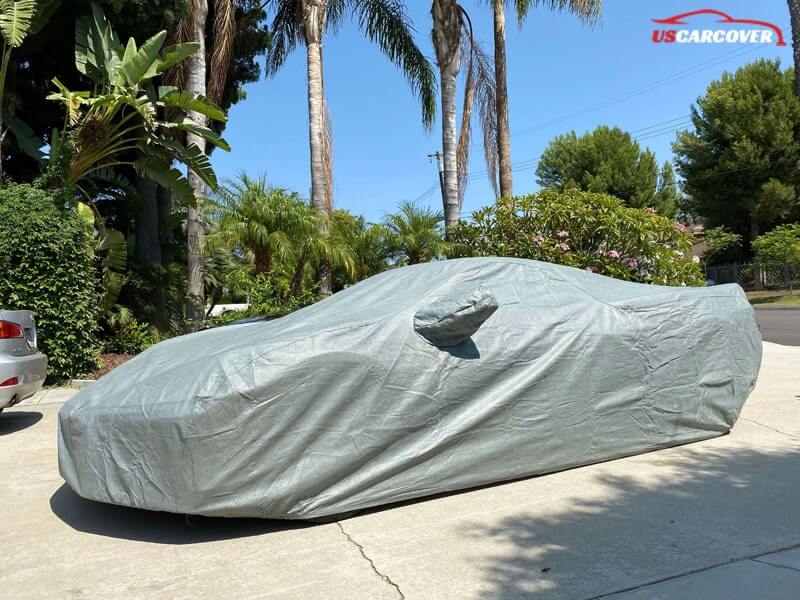
Saves You Money on Repairs
The cost of repairing sun damage can add up. Repainting your car, repairing a cracked dashboard, or replacing faded seats can be expensive. Investing in a UV-protective car cover is a small price to pay compared to the potential cost of these repairs. It’s a preventative measure that can save you hundreds, if not thousands, of dollars in the long run.
In short, a car cover with UV protection is more than just a layer of fabric—it’s an essential accessory for preserving the beauty and functionality of your vehicle. Whether you’re dealing with blazing hot summers or year-round sun exposure, the right car cover can make all the difference in protecting your investment.
Related Posts: How to Properly Store Your Car Cover: A Comprehensive Guide
Key Features to Look for in a Car Cover for Hot Weather
Choosing the right car cover for hot weather involves more than just picking a pretty design or a low price. To ensure your vehicle gets the best protection against the sun’s harsh rays, you need to consider several important features. Here’s what to look for when selecting a car cover to beat the heat:
UV-Reflective Material
The primary function of a car cover in hot weather is to protect against UV rays. Look for covers made from UV-reflective materials that block and deflect sunlight. These fabrics are often coated or treated with special substances designed to reflect UV rays away from your vehicle, significantly reducing the risk of paint fade and interior damage. Materials like polyester, nylon, or special UV-treated fabrics are common choices for effective UV protection.
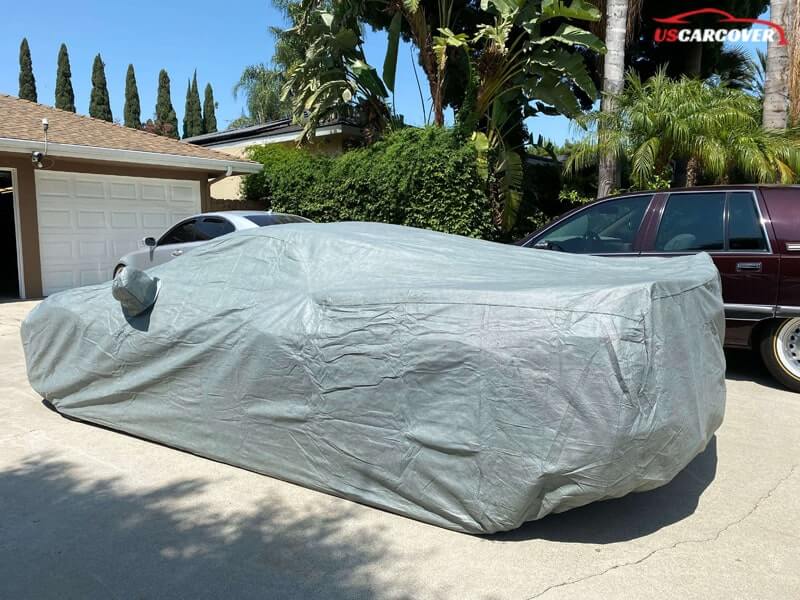
Breathability
A good car cover should not only protect your car from UV rays but also allow air to circulate underneath. Breathable fabrics help prevent moisture from getting trapped between the cover and your car’s surface, which can lead to mold and mildew growth. Breathability also helps reduce heat build-up inside the cover, keeping your car cooler. Look for covers with mesh or vented designs to enhance airflow.
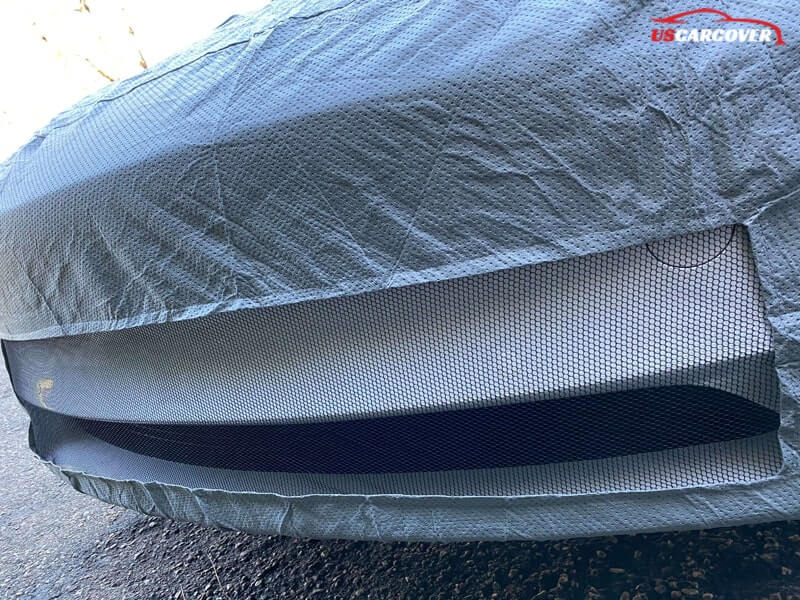
Water-Resistant vs. Waterproof
While UV protection is crucial, consider whether you need water resistance as well. Water-resistant covers provide a barrier against light rain and dew, which can be useful in maintaining your car's condition. Waterproof covers, on the other hand, offer a more robust shield against heavy rain but may be less breathable. In hot climates where rain is infrequent, water resistance might be sufficient. Choose based on your specific weather conditions and how much rain your area receives.
Durability & Scratch Resistance
The car cover should be durable enough to withstand frequent use and harsh weather conditions. Check for reinforced seams and high-quality stitching, which ensure longevity. Additionally, an inner layer with a soft, scratch-resistant finish will protect your car’s paint from scratches or abrasions. Avoid covers with rough linings or low-quality materials that might damage your vehicle’s finish.
Easy Storage and Portability
Car covers should be easy to handle, store, and transport. Lightweight materials are generally more convenient for regular use. Many covers come with their own storage bags or pouches, making them easy to stow away when not in use. Consider how easily the cover can be folded and carried, especially if you plan to use it frequently or store it in a small space.
Custom Fit vs. Universal Fit
Choosing between a custom-fit and universal-fit car cover depends on your needs and budget. Custom-fit covers are tailored to the exact dimensions of your vehicle, providing superior protection and a snug fit. They offer the best coverage and are less likely to shift or blow off in the wind. Universal-fit covers, while more affordable, are designed to fit a range of vehicle sizes and shapes. They may not offer the same level of protection or coverage but can be a good option for a more budget-conscious buyer.
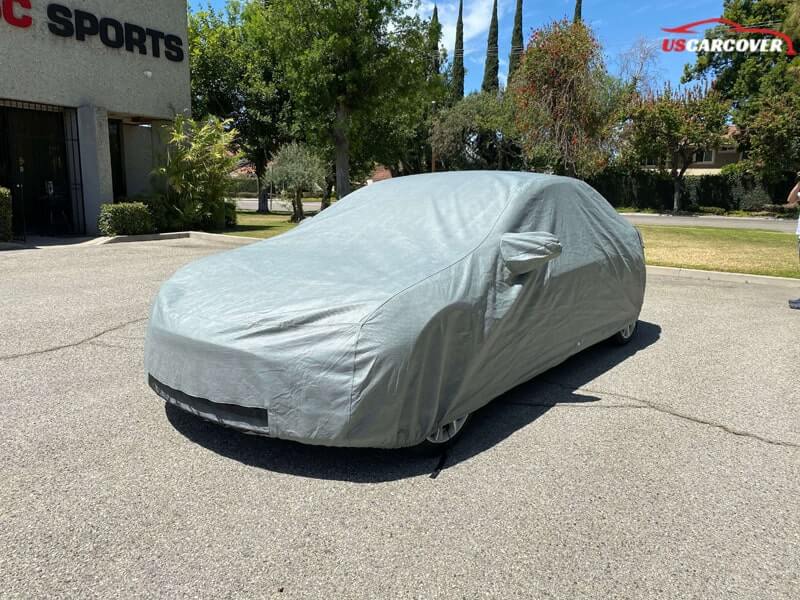
Additional Features
Some car covers come with extra features that can add to their effectiveness:
- Anti-Theft Features: Look for covers with built-in grommets or straps that can be locked to deter theft.
- Reflective Strips: Some covers have reflective strips for better visibility and added safety.
- Elastic Hems & Straps: Elastic hems and adjustable straps help ensure a secure fit, preventing the cover from blowing off in strong winds.
When selecting a car cover for hot weather, it’s essential to balance protection, durability, and convenience. By focusing on these key features, you can ensure that your vehicle stays shielded from the sun’s harmful effects while remaining easy to use and maintain.
Top 5 Car Covers for UV Protection in Hot Weather
When it comes to finding the best car cover for hot weather, there are several top contenders that excel in UV protection and overall performance. Here’s a rundown of the top five car covers designed to keep your vehicle cool, protected, and looking great:
1. Covercraft WeatherShield HP Car Cover
- Material & UV-Protection Rating: Made from a patented multi-layer fabric that provides excellent UV resistance and protects against heat. The fabric is treated to reflect UV rays and reduce heat absorption.
- Fit: Available in both custom and universal fits. Custom-fit options provide a tailored, snug fit that enhances protection.
- Price Range: Mid to high-end, reflecting its premium quality and durability.
- Additional Features: Breathable, water-resistant, and designed for outdoor use. Features a soft inner lining to protect your car’s finish and reinforced seams for durability.
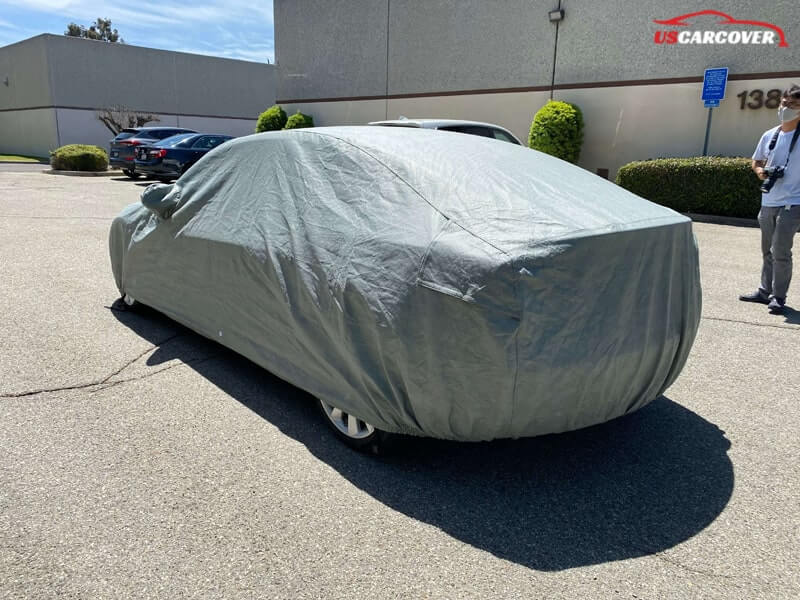
2. WeatherTech Premium Car Cover
- Material & UV-Protection Rating: Constructed from a high-density polyester fabric with UV inhibitors. Provides strong protection against UV rays and helps keep your car cool.
- Fit: Available in custom-fit and universal sizes. Custom-fit covers are designed for specific vehicle models.
- Price Range: Mid-range, offering great value for its level of protection and durability.
- Additional Features: Breathable and water-resistant, with a built-in grommet system for security. The cover is also easy to fold and store, making it convenient for regular use.
3. Motor Trend FlexShade Car Cover
- Material & UV-Protection Rating: Features a high-quality, UV-resistant fabric that reflects sunlight and reduces heat buildup. Ideal for intense sun exposure.
- Fit: Universal fit, designed to accommodate a wide range of vehicle sizes.
- Price Range: Budget-friendly, making it an excellent choice for those looking for effective protection without breaking the bank.
- Additional Features: Lightweight and compact for easy storage. Includes an elastic hem for a snug fit and reinforced grommets for added security.
4. Coverking Stormproof Car Cover
- Material & UV-Protection Rating: Made from a unique blend of high-strength polyester fabric and a weather-resistant coating. Provides exceptional UV protection and is built to withstand harsh weather conditions.
- Fit: Custom-fit options available for various vehicle models, ensuring a perfect fit and maximum coverage.
- Price Range: Higher-end, reflecting its advanced materials and custom-fit design.
- Additional Features: Features a soft, non-abrasive inner layer, adjustable straps, and reinforced grommets. The cover is also highly breathable and water-resistant.
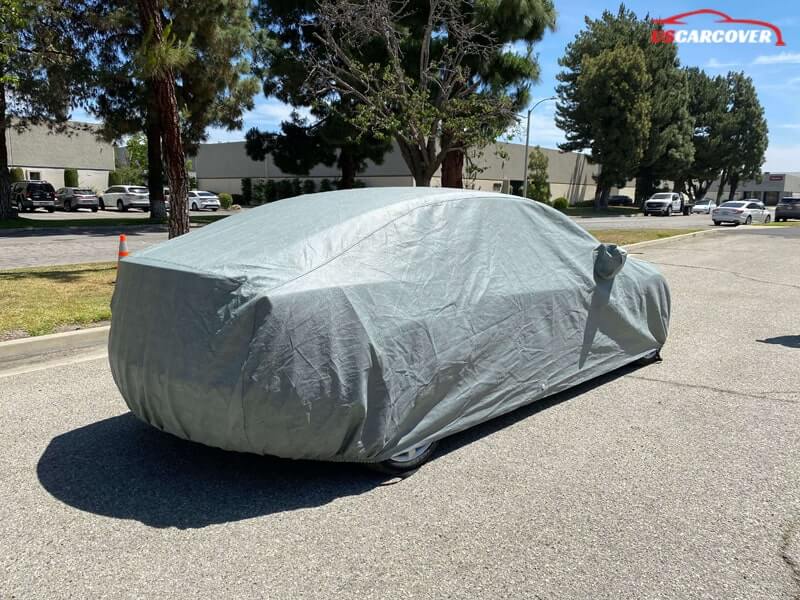
5. Budge Lite Car Cover
- Material & UV-Protection Rating: Constructed from a lightweight, UV-resistant material that offers basic protection against the sun’s rays. Suitable for moderate sun exposure.
- Fit: Universal fit, designed to cover a range of vehicle sizes.
- Price Range: Low to mid-range, ideal for those seeking an affordable option.
- Additional Features: Water-resistant and includes an elasticized hem for a secure fit. The cover is easy to install and remove, making it a practical choice for everyday use.
Each of these car covers offers unique features suited to different needs and budgets. Whether you’re looking for premium protection, a custom fit, or a cost-effective option, these top picks ensure your vehicle remains shielded from the damaging effects of hot weather and UV rays. Consider your specific requirements and preferences to select the best cover that fits your vehicle and lifestyle.
How to Properly Use and Maintain a Car Cover in Hot Weather
To get the most out of your car cover, proper usage and maintenance are key. Following these guidelines will help you maximize the benefits of your cover, ensuring that your vehicle stays protected and your cover lasts as long as possible.
Correct Application
- Clean Your Vehicle: Before covering your car, ensure that it is clean and dry. Dirt, dust, and moisture trapped under the cover can cause scratches or promote mold growth.
- Proper Positioning: Align the cover with your vehicle’s dimensions. If using a custom-fit cover, it should fit snugly over your car. For universal-fit covers, make sure the cover is evenly distributed and covers the entire vehicle.
- Secure the Cover: Use any straps, grommets, or elastic hems provided with the cover to ensure it stays in place. For added security, especially in windy conditions, consider using additional tie-downs or weights if the cover allows for them.
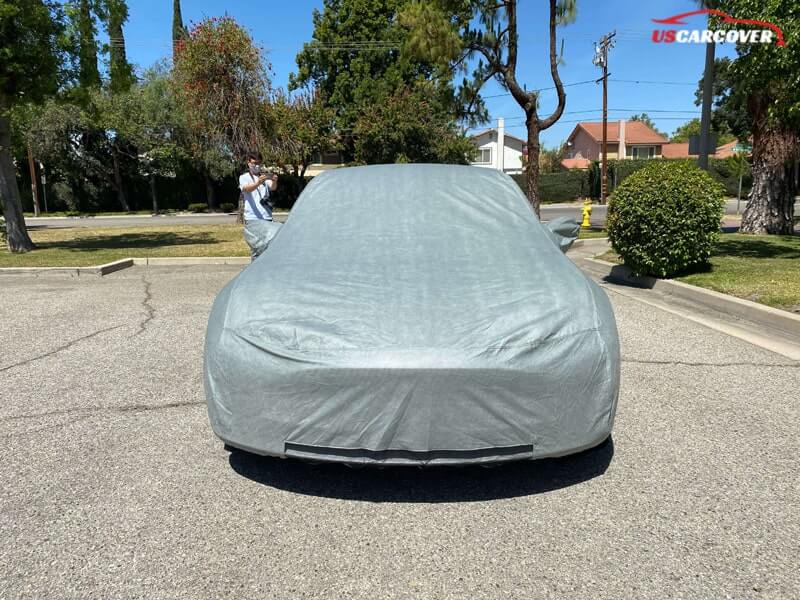
Cleaning and Storing Your Cover
- Regular Cleaning: Follow the manufacturer’s instructions for cleaning your car cover. Most can be machine washed or spot cleaned with mild detergent. Avoid using harsh chemicals or bleach, as these can damage the fabric.
- Dry Completely: Always ensure the cover is completely dry before storing it. Moisture left on the cover can lead to mildew or mold growth.
- Proper Storage: Store your cover in a cool, dry place away from direct sunlight. Many covers come with a storage bag or pouch, which helps keep the cover compact and protected when not in use. Avoid storing the cover in damp or humid areas to prevent mold growth.
Avoiding Common Mistakes
- Don’t Cover a Dirty or Wet Car: Always clean your car before covering it. Dirt and moisture trapped under the cover can damage your vehicle’s paint and promote mold or mildew.
- Check for Proper Fit: Ensure the cover is the correct size for your vehicle. A cover that is too small can leave parts of your car exposed, while a cover that is too large can move around, leading to potential damage.
- Avoid Using Harsh Cleaners: When cleaning your cover, use gentle cleaners that are recommended by the manufacturer. Harsh chemicals can degrade the fabric and reduce its effectiveness.
Additional Tips for Hot Weather
- Check for UV Damage Regularly: Inspect your car and cover periodically for signs of UV damage. If you notice any issues, address them promptly to prevent further damage.
- Consider a Reflective Shade: If your car cover doesn’t include a reflective layer, you might consider adding a windshield sunshade to further reduce interior temperatures and UV exposure.
- Adjust for Seasonal Changes: In cooler weather or when not in use, adjust your car cover practices accordingly. Some covers are designed for all-season use and can be adapted as needed.
By following these best practices for using and maintaining your car cover, you’ll ensure that your vehicle remains protected from the damaging effects of hot weather and UV rays. Proper care not only extends the life of your cover but also keeps your car looking and performing its best.
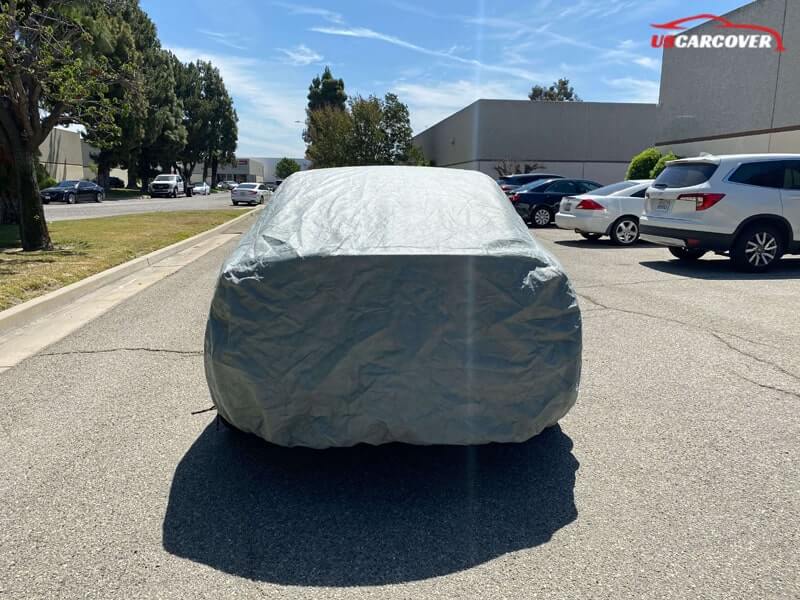
FAQ: Car Covers for Hot Weather
When considering a car cover for hot weather, you might have several questions. Here are some frequently asked questions and their answers to help you make an informed decision:
Can car covers damage paint?
Car covers are generally designed to protect your vehicle’s paint, but improper use can potentially cause damage. To avoid this:
- Ensure the car and cover are both clean before use to prevent scratching.
- Use a cover with a soft, non-abrasive inner lining.
- Avoid using covers with rough or dirty surfaces.
- Regularly inspect the cover for wear and replace it if it becomes damaged.
How do I choose the right size car cover?
Choosing the right size is crucial for effective protection. Here’s how to select the right fit:
- Custom Fit: Opt for a custom-fit cover if you want a precise fit for your specific vehicle model. These covers are tailored to your car’s exact dimensions.
- Universal Fit: For a more budget-friendly option, universal-fit covers can accommodate a range of vehicle sizes. Measure your car’s length, width, and height, and compare it with the cover’s dimensions to ensure a suitable fit.
- Check Manufacturer Guidelines: Always refer to the manufacturer’s size chart or recommendations for the best results.
Are all car covers UV-resistant?
Not all car covers are created equal when it comes to UV resistance. To ensure effective protection:
- Look for covers specifically labeled as UV-resistant or UV-protective.
- Check the material’s specifications for UV-blocking properties.
- Consider covers made from reflective or multi-layered fabrics designed to deflect UV rays.
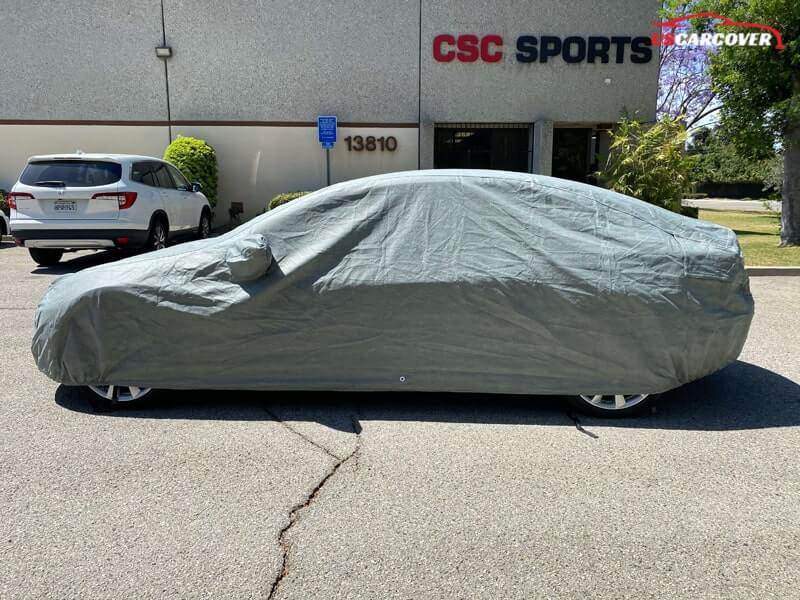
How much cooler will a UV-protective car cover keep my vehicle?
The degree to which a UV-protective car cover can keep your vehicle cooler depends on several factors:
- Material Quality: High-quality UV-reflective and heat-resistant materials will generally offer better temperature control.
- Cover Design: Covers with additional insulating layers or reflective coatings can further reduce heat build-up.
- Environmental Conditions: The effectiveness of a cover can also be influenced by external factors such as ambient temperature and sunlight intensity.
While a UV-protective cover can significantly lower interior temperatures compared to no cover at all, the exact cooling effect can vary. Using a cover in combination with other measures, like window shades or tinting, can enhance overall temperature control.
This FAQ section addresses common concerns and provides helpful insights to guide your decision-making process. By understanding these aspects, you’ll be better equipped to select and use a car cover that meets your needs for hot weather protection.
Conclusion
In the relentless heat of summer, your vehicle deserves the best protection against the sun’s damaging rays. A high-quality UV-protective car cover is more than just a safeguard; it’s an investment in your car’s longevity and appearance. By shielding your vehicle from UV rays, you prevent paint fade, interior damage, and excessive heat build-up, all of which contribute to the overall preservation and value of your car.
In this guide, we’ve explored the critical features to look for in a car cover, including UV-reflective materials, breathability, durability, and fit. We’ve also highlighted some of the top-rated car covers available on the market, each offering unique benefits suited to different needs and budgets. Whether you’re looking for a premium option with all the bells and whistles or a more budget-friendly choice that still offers solid protection, there’s a cover out there that’s right for you.
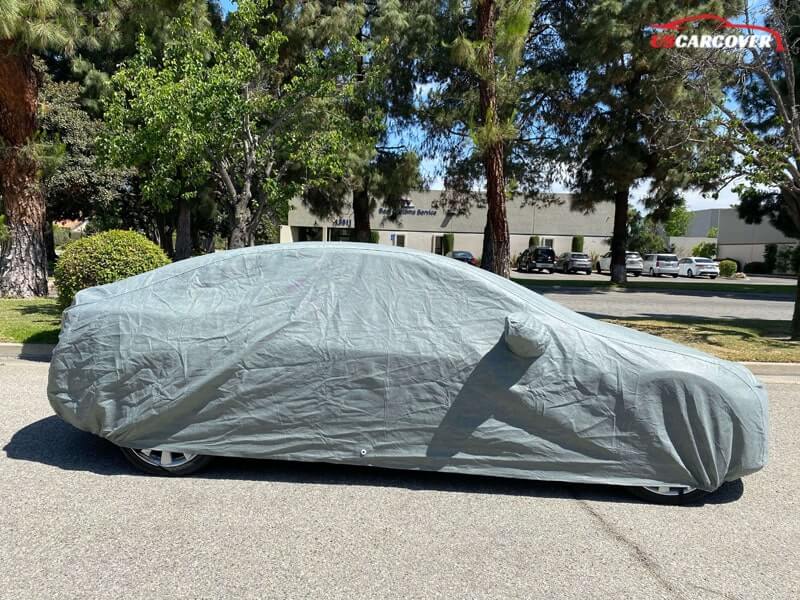
Remember, choosing the right car cover is only part of the equation. Proper use and maintenance are key to ensuring your cover remains effective over time. By following the recommended practices for application, cleaning, and storage, you’ll extend the life of both your car cover and your vehicle.
Don’t wait for the sun to take its toll on your car. Invest in a UV-protective car cover today and give your vehicle the protection it deserves. Browse through our recommended top picks, consider your specific needs, and make a choice that will keep your car looking fresh and feeling cool no matter how hot it gets outside.
Keep your car protected, preserve its value, and enjoy peace of mind knowing that you’ve taken the right steps to shield your investment from the harsh effects of hot weather.
